Claudia Jansen: Ursache & Wirkung – Grafik in der DDR aus der Sammlung Nowoisky
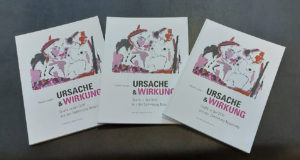 In the last years, every now and then there were exhibitions of artworks created in the GDR (German Democratic Republic). By the time, the perspective changed and the focus on quality progressed, instead of a political judgement. Most of these shows were a compilation of diverse artists from different provenances. Now the Municipal Museums of Zittau, Germany presents a large range of graphic prints, all coming from one private collection. A particularity of this collection is that the oeuvres were mainly bought closely to the creation and not by renowned art patrons or as investment, but only for pleasure for art. For people who like to get an impression or who are not able to travel until January 30th 2022 to the town at the border to Poland and the Czech Republic, there is a catalogue. Due to the numerous illustrations (50 photos), it also could be interesting for non-German speaking art lovers to discover rather unknown artists in their diversity of subjects and techniques.
In the last years, every now and then there were exhibitions of artworks created in the GDR (German Democratic Republic). By the time, the perspective changed and the focus on quality progressed, instead of a political judgement. Most of these shows were a compilation of diverse artists from different provenances. Now the Municipal Museums of Zittau, Germany presents a large range of graphic prints, all coming from one private collection. A particularity of this collection is that the oeuvres were mainly bought closely to the creation and not by renowned art patrons or as investment, but only for pleasure for art. For people who like to get an impression or who are not able to travel until January 30th 2022 to the town at the border to Poland and the Czech Republic, there is a catalogue. Due to the numerous illustrations (50 photos), it also could be interesting for non-German speaking art lovers to discover rather unknown artists in their diversity of subjects and techniques.
About the background of the collection Nowoisky and the selection criteria
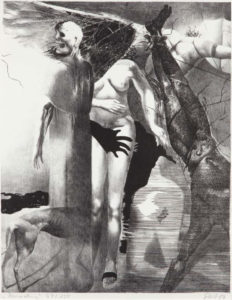 In the beginning 1970s the couple Georg and Lore Nowoisky started to get interested in art. In 1973, they travelled for the first time together to Köthen, at this time GDR, where Georg grew up. On this occasion, they invested their obligatory minimum exchange* in artworks. For their choice, they visited artist studios, state-run galleries, graphic auctions, private and producer galleries inter alia in Berlin, Leipzig, Halle and Dresden. From the now 50 years of passion for art and yearly voyages into the GDR, results a vast collection of primary graphic prints. Within the approx. 1.600 works, there is a focus on the eastern part of Germany (65% from 250 artists). The curator and author of the catalogue texts, Claudia Jansen has chosen 80 oeuvres, bought in the 1970s and 80s. There are non-figurative works beside those in the manner of (engaged) realism, with a thematic range including religion, mythology and literature likewise genre representations from pubs, circus and erotic scenes.
In the beginning 1970s the couple Georg and Lore Nowoisky started to get interested in art. In 1973, they travelled for the first time together to Köthen, at this time GDR, where Georg grew up. On this occasion, they invested their obligatory minimum exchange* in artworks. For their choice, they visited artist studios, state-run galleries, graphic auctions, private and producer galleries inter alia in Berlin, Leipzig, Halle and Dresden. From the now 50 years of passion for art and yearly voyages into the GDR, results a vast collection of primary graphic prints. Within the approx. 1.600 works, there is a focus on the eastern part of Germany (65% from 250 artists). The curator and author of the catalogue texts, Claudia Jansen has chosen 80 oeuvres, bought in the 1970s and 80s. There are non-figurative works beside those in the manner of (engaged) realism, with a thematic range including religion, mythology and literature likewise genre representations from pubs, circus and erotic scenes.
Criteria for the selection of the now presented oeuvres were to show these divers facets. Moreover, it was important to include the female artists, because they were proportionally better represented in the GDR than in western countries, even though equality was not completed. There is no classification between official and unofficial art, since the distinction is partly impossible. Moreover, these characteristics are not determining the quality.
Graphic prints in the GDR: a special form of artistic expression
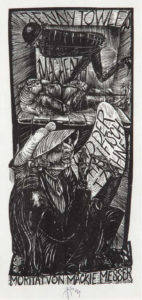 Whereas the government of the GDR focussed in the 1960s more on painting and sculpture to represent its ideas, graphic prints became more important in the 1970s. Due to the technique’s inherent duplication skills, it was interesting for the artists, because it enabled a larger distribution to the public. Going along with this, it gave higher income opportunities to them, even without official print permission. For editions under 100 prints, there was no authorisation needed. At the same time, people got more interested in art, supposedly by an increasing level of education. Since the essential living expenses were relatively low and consumer goods rather rare, art was a possibility to enrich the life otherwise. Compared to unique pieces, graphic prints were and are still less expensive. In consequence, they are more accessible to the public. Additionally, the government started to organise official exhibitions, graphic exchange events and auctions. Herewith, the idea of open access to art was adopted. Besides, the notion of art for everyone was also a guiding line for several western artist movements, but less for the governments.
Whereas the government of the GDR focussed in the 1960s more on painting and sculpture to represent its ideas, graphic prints became more important in the 1970s. Due to the technique’s inherent duplication skills, it was interesting for the artists, because it enabled a larger distribution to the public. Going along with this, it gave higher income opportunities to them, even without official print permission. For editions under 100 prints, there was no authorisation needed. At the same time, people got more interested in art, supposedly by an increasing level of education. Since the essential living expenses were relatively low and consumer goods rather rare, art was a possibility to enrich the life otherwise. Compared to unique pieces, graphic prints were and are still less expensive. In consequence, they are more accessible to the public. Additionally, the government started to organise official exhibitions, graphic exchange events and auctions. Herewith, the idea of open access to art was adopted. Besides, the notion of art for everyone was also a guiding line for several western artist movements, but less for the governments.
In turn, the artists reacted to the higher demand. They published folders, which were monographic or subject orientated. Later, they added special designed boxes and graphic calendars. The illustration or visual interpretation of literary texts propagated. Even after the collapse of the political system and the German reunification, several artists continued this practice and are still doing so.
The picture section: More than only graphic prints
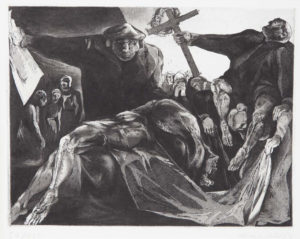 As already said, the collectors Georg and Lore Nowoisky travelled across the GDR, in particular to the cities with renowned art schools, namely Berlin, Dresden, Halle and Leipzig. Claudia adopted this classification, even though it is slightly blurring. To frequent a particular academy could influence the artistic work by similarity, the opposite or even something totally different. Besides, there are always personal conditions and external impacts, which could be reflected in the oeuvre of an artist. Moreover, depending on the period of origin of an artwork, it might show only a special moment in a longer development. Obviously, an exhibition with so many artists stays abreast of these changes. Hence, the assignment of the artists to a special art school means first of all that they studied or taught there. A fifth section is dedicated to artists, which were never part of an art school, neither as student nor as teacher. Therefore, they could be referred to as autodidacts. Likewise, in the exhibition as in the catalogue, these artists are presented in the section “individual school”. Despite the difficulties of the classification, there is a short history of each art school as prefix to every section. It is about the historic development and the placement within the time of the GDR.
As already said, the collectors Georg and Lore Nowoisky travelled across the GDR, in particular to the cities with renowned art schools, namely Berlin, Dresden, Halle and Leipzig. Claudia adopted this classification, even though it is slightly blurring. To frequent a particular academy could influence the artistic work by similarity, the opposite or even something totally different. Besides, there are always personal conditions and external impacts, which could be reflected in the oeuvre of an artist. Moreover, depending on the period of origin of an artwork, it might show only a special moment in a longer development. Obviously, an exhibition with so many artists stays abreast of these changes. Hence, the assignment of the artists to a special art school means first of all that they studied or taught there. A fifth section is dedicated to artists, which were never part of an art school, neither as student nor as teacher. Therefore, they could be referred to as autodidacts. Likewise, in the exhibition as in the catalogue, these artists are presented in the section “individual school”. Despite the difficulties of the classification, there is a short history of each art school as prefix to every section. It is about the historic development and the placement within the time of the GDR.
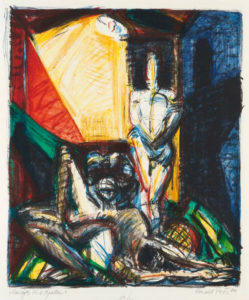 For each of the 50 depicted graphic prints Claudia wrote a little text about the oeuvre. Therein, she often gives the artists themselves a voice. These comments are mostly the result of a direct request to the artists, if they are still alive. Interesting is how they remind the initial motivation after more than 40 years. A short CV of each artist completes the picture section.
For each of the 50 depicted graphic prints Claudia wrote a little text about the oeuvre. Therein, she often gives the artists themselves a voice. These comments are mostly the result of a direct request to the artists, if they are still alive. Interesting is how they remind the initial motivation after more than 40 years. A short CV of each artist completes the picture section.
In total, the catalogue gives many insides in the artistic activity in the vanished state of the GDR. Like numerous other phenomena of this former German socialist state, the artists were often underestimated after the collapse and the accession to the FRG (Federal Republic of Germany). The discussion about the value of state commissioned obscured the view at the artworks. After more than thirty years, it could be time to refresh the look and contemplate the oeuvres themselves unbiased. So it might be possible to appreciate these graphic prints like the collector couple, the curator and the museum management are doing.
Ursache & Wirkung – Grafik in der DDR aus der Sammlung NowoiskyAuthor: Claudia Jansen
Editor: Verein Zittauer Fastentücher in cooperation with the Städtischen Museen Zittau
Copyright of the oeuvres: © VG Bild-Kunst, Bonn 2021
ISBN 978-3-944560-81-6
2021
92 pages
Softcover
Publishing house: Verlag Gunter Oettel, www.verlag-oettel.de
10 €
* Since 1964, it was obligatory for most visitors from non-socialist countries to change a minimum of their currency into East German marks per day. In 1973, this exchange was 20 western Deutsche Mark into 20 East German mark, one to one, even though the East German mark’s value was much less. In the 1980s, the exchange rate at the black market was about 5 to 10 East German marks. The minimum exchange varied by the time. In 1989, the amount was 25 western German marks per day.
















